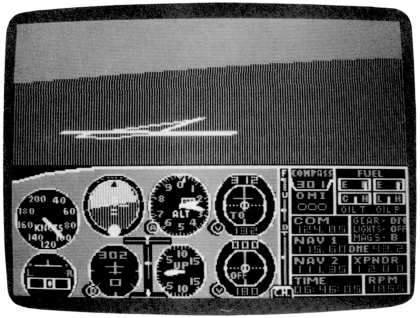40 More Great Flight Simulator Adventures
by Charles Gulick

Ferry from
Nantucket
Nantucket
| North Position: 17457 | Rudder: 32767 |
| East Position: 22196 | Ailerons: 32767 |
| Altitude: 69 | Flaps: 0 |
| Pitch: 0 | Elevators: 32767 |
| Bank: 0 | Time: 6:30 |
| Heading: 330 | Season: 2-Spring |
| Airspeed: 0 | Cloud Layer 1: 12000, 10000 |
| Throttle: 0 | Wind: 3 Kts, 325 |
| This airport doesn't show up in
the simulator, but it's here. In fact, you're in position for takeoff
on runway 33. If you have the FAA New York sectional chart, you'll see that there are actually three airstrips here at Somerset Airport on Nantucket Island, which is off the southern coast of Massachusetts. On the simulator charts, the island is shown (but not identified) to the east and a bit south of Martha's Vineyard. You can see the relationship clearly on radar. So many ships were wrecked from this storied whaling port that they built a windmill from the timbers that washed ashore. In the summer, passenger ferries operate between Nantucket and Hyannis Port to the north, and Woods Hole and New Bedford to the northwest. Fortunately, with wings, we don't have to wait for summer. |
|
 |
Tune your NAV to Martha's
Vineyard VOR, 108.2, and center the OBI
needle. Then prep for your normal takeoff. Plan a left turn to fly the
OMNI radial as you pass through 500 feet. Our cruise altitude will be
2300. Roll 'em. |
 |
You'll see Martha's Vineyard
ahead as soon as you're on course. About
14 nautical miles out, the runways will come into view. Your heading
takes you directly over a rather famous landmark, Chappaquiddick
Island, with its equally famous bridge, right about where you make
landfall. |
 |
When the runways of Martha's
Vineyard are just ahead of your nose, tune
your NAV to Providence VOR, 115.6, and change your course to fly the
312 radial to that station. The water under you is Buzzards Bay, part of Rhode Island Sound. You'll fly to the left of Woods Hole, famous for its oceanographic research, and across the coast of Massachusetts just below New Bedford. There are several airports in the real world around Providence, Rhode Island, but they're not in the simulation. So we'll plan to land at Danielson Airport in Connecticut. |
 |
Danielson has one runway, 13/31.
Since the wind is about three knots at
325 degrees, they'll be landing on 31. The runway bears on the
300-degree radial from the Providence OMNI. If we get on that radial
once we're over Providence VOR, we should be almost lined up for a
straightin approach. A few miles out of Providence, set the OBI to 300. When the reading changes to FROM, turn left to intercept that radial and center the needle. Once you have your heading, switch to Putnam VOR, 117.4, and your DME will show you the approximate distance to Danielson, since the Putnam OMNI is nearly the same distance. Soon, like magic, you'll see the Danielson runway ahead. And the whole exercise becomes visual. Elevation at Danielson is 239 feet. You're at 2300 (supposedly). Remember, the runway is on a heading of 310. You'll want to get over to your left a bit to get lined up. Back off to pattern speed and take on ten degrees of flaps as you let down. Gently. Gently. With so much time to prepare for it, this should be one of your better landings, shouldn't it? But two things are certain: If this is one of your better landings, there won't be a soul at Danielson to see it, and if it's one of your worst, half the population of the county will be out at the airport this nice spring morning. Watching the airplanes fly. |
Table of Contents | Previous Section | Next Section
